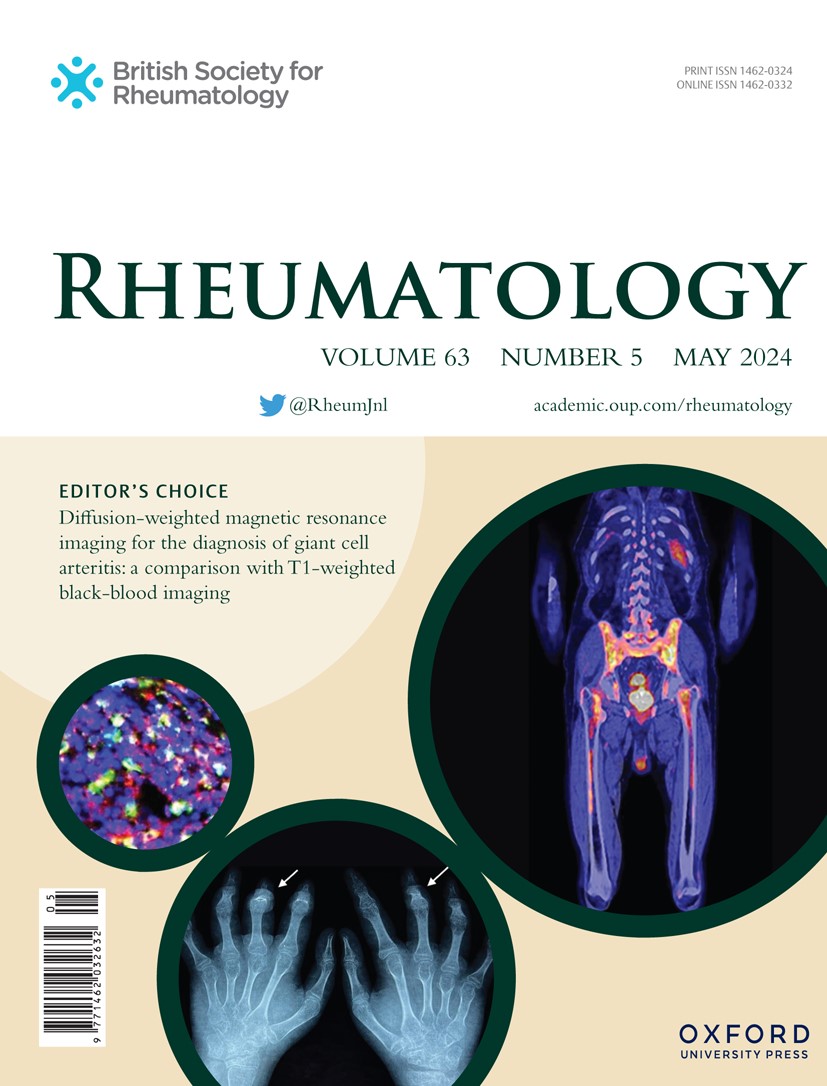N-formyl methionine peptide-driven neutrophil activation in idiopathic inflammatory myopathies.
IF 4.4
2区 医学
Q1 RHEUMATOLOGY
引用次数: 0
Abstract
OBJECTIVE Neutrophil activation is heightened in inflammatory myopathies and associated with disease activity, yet its mechanisms remain unclear. This study explores the role of N-formyl methionine (fMET) in formyl peptide receptor 1 (FPR1)-mediated neutrophil activation in idiopathic inflammatory myopathies (IIMs), focusing on dermatomyositis (DM) and inclusion body myositis (IBM). METHODS Plasma from IBM (n = 46), DM (n = 40), and healthy controls (n = 40) was analyzed for fMET, calprotectin, neutrophil elastase DNA (NE-DNA), and cytokines using ELISA. Neutrophil markers CD11b and CD66b were assessed by flow cytometry following plasma stimulation with or without FPR1 inhibition. Correlation analyses were performed between fMET, muscle strength (MMT8), and neutrophil activation markers. RESULTS DM and IBM patients had significantly higher plasma fMET levels than controls (p< 0.0001 for DM; p= 0.0002 for IBM). Median fMET levels were 13 719 pg/ml (75th percentile: 17 236 pg/ml) for IBM, 14 780 pg/ml (75th percentile: 17 631 pg/ml) for DM, and 8,449 pg/ml (75th percentile: 12 632 pg/ml) for controls. fMET correlated inversely with MMT8 in antibody-negative IBM (r=-0.53, p= 0.02). Calprotectin was elevated in DM (p= 0.01) but not IBM; NE-DNA complexes were increased in both DM (p= 0.03) and IBM (p< 0.0001). FPR1 inhibition significantly reduced plasma-induced neutrophil activation in DM (p< 0.0001) and IBM (p= 0.0012), restoring CD66b and partially CD11b to control levels. CONCLUSION Our findings show that fMET-FPR1 signalling drives neutrophil activation in DM and IBM, promoting inflammation and muscle damage. Targeting this pathway may offer a novel IIM therapy.特发性炎性肌病中n -甲酰基蛋氨酸肽驱动的中性粒细胞活化。
目的:中性粒细胞激活在炎性肌病中升高,并与疾病活动性相关,但其机制尚不清楚。本研究探讨了n -甲酰基蛋氨酸(fMET)在特发性炎性肌病(IIMs)中甲酰基肽受体1 (FPR1)介导的中性粒细胞激活中的作用,重点是皮肌炎(DM)和包络体肌炎(IBM)。方法采用ELISA法分析IBM (n = 46)、DM (n = 40)和健康对照(n = 40)的血浆中fMET、钙保护蛋白、中性粒细胞弹性酶DNA (NE-DNA)和细胞因子的含量。在FPR1抑制或不抑制血浆刺激后,流式细胞术检测中性粒细胞标志物CD11b和CD66b。对fMET、肌力(MMT8)和中性粒细胞激活标志物进行相关性分析。结果DM和IBM患者血浆fMET水平显著高于对照组(DM组p< 0.0001, IBM组p= 0.0002)。IBM组中位fMET水平为13 719 pg/ml(第75百分位数:17 236 pg/ml), DM组为14 780 pg/ml(第75百分位数:17 631 pg/ml),对照组为8,449 pg/ml(第75百分位数:12 632 pg/ml)。抗体阴性的IBM患者fMET与MMT8呈负相关(r=-0.53, p= 0.02)。DM组钙护蛋白升高(p= 0.01), IBM组钙护蛋白升高(p= 0.01);DM (p= 0.03)和IBM (p< 0.0001)中NE-DNA复合物均增加。FPR1抑制显著降低DM (p< 0.0001)和IBM (p= 0.0012)血浆诱导的中性粒细胞活化,使CD66b和部分CD11b恢复到控制水平。我们的研究结果表明,fMET-FPR1信号驱动DM和IBM的中性粒细胞激活,促进炎症和肌肉损伤。靶向这一途径可能提供一种新的IIM治疗方法。
本文章由计算机程序翻译,如有差异,请以英文原文为准。
求助全文
约1分钟内获得全文
求助全文
来源期刊

Rheumatology
医学-风湿病学
CiteScore
9.40
自引率
7.30%
发文量
1091
审稿时长
2 months
期刊介绍:
Rheumatology strives to support research and discovery by publishing the highest quality original scientific papers with a focus on basic, clinical and translational research. The journal’s subject areas cover a wide range of paediatric and adult rheumatological conditions from an international perspective. It is an official journal of the British Society for Rheumatology, published by Oxford University Press.
Rheumatology publishes original articles, reviews, editorials, guidelines, concise reports, meta-analyses, original case reports, clinical vignettes, letters and matters arising from published material. The journal takes pride in serving the global rheumatology community, with a focus on high societal impact in the form of podcasts, videos and extended social media presence, and utilizing metrics such as Altmetric. Keep up to date by following the journal on Twitter @RheumJnl.
 求助内容:
求助内容: 应助结果提醒方式:
应助结果提醒方式:


